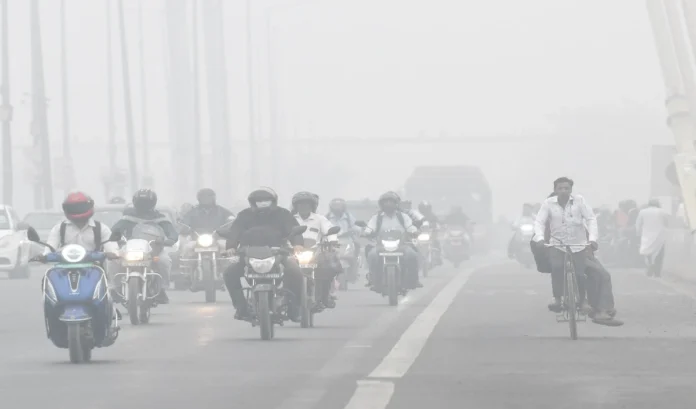The air quality situation in the national capital Delhi has worsened. Due to poor air quality, people in Delhi are facing problems in breathing. Meanwhile, on Friday also the air quality situation in many areas of Delhi was recorded in the serious category. During this period, a thick layer of smog once again covered the National Capital Region including Noida, Ghaziabad and Gurugram.
The fall in the air quality index or AQI prompted the central pollution watchdog Air Quality Management Commission to impose restrictions under the third phase of the Graded Response Action Plan, which includes ban on construction activities and sale of BS-III petrol and BS-IV diesel vehicles in the city and NCR. Includes restrictions on walking.
The restrictions will come into effect from 8 am on Friday. The Delhi government has also announced that due to dangerous levels of pollution, physical classes will not be held in primary schools until further orders, but online classes can continue. According to Central Pollution Control Board (CPCB) data, the AQI in Delhi’s Anand Vihar was 441 at 6 am on Thursday. Bawana (455), Dwarka Sector 8 (444) and Jahangiruri (458) are some of the areas where the worst air quality was recorded in Delhi. The air quality crossed 400, which falls in the severe category.
This is the situation of Delhi air pollution
– The Air Quality Management Commission said in an order that the Delhi government and NCR states will impose strict restrictions on BS-III petrol and BS-IV diesel (four-wheelers) in the national capital and neighboring Gurugram, Faridabad, Ghaziabad and Gautam Buddha Nagar. Any violation will attract a fine of Rs 20,000.
– Under the third phase of GRAP, all interstate buses from NCR states will be stopped from entering Delhi, along with strict restrictions on construction and demolition activities, mining-related activities will be suspended, daily watering of major roads will be sprayed and students up to class 5 can be considered for online classes.
– Electric vehicles, CNG vehicles and BS-VI diesel buses will be allowed to run in NCR. CAQM said construction activities, which are relatively less polluting and less dust generating, will be allowed in the NCR, provided that C&D waste management rules are strictly followed.
– Delhi Metro Rail Corporation (DMRC) said that in view of the implementation of GRAP-III, 20 additional trips will be introduced on weekdays from Friday (in addition to the 40 trips already running since the implementation of GRAP-II).
The AQI recorded daily at 4 pm in the city was 424, which was 418 the previous day. Of the 39 monitoring stations in Delhi, 27 reported the air quality to be in the ‘severe’ category. These stations include Anand Vihar, Ashok Vihar, Aya Nagar, Bawana, Dwarka Sector 8, IGI Airport, ITO, Jahangirpuri, Mandir Marg, Mundka, Najafgarh, Narela, Nehru Nagar, North Campus, Patparganj and Punjabi Bagh.
A round of political allegations and counter-allegations started on Thursday regarding the worsening level of pollution. Bharatiya Janata Party targeted Delhi Environment Minister Gopal Rai and asked for his resignation. The party said the air quality in the city is moving towards dangerous levels.
Gopal Rai hit back and accused the BJP led governments of neighboring states of doing nothing to stop air pollution.
– The GRAP for Delhi-NCR has been divided into four phases of air quality – Phase 1 for “poor” air quality index (AQI) between 201 and 300, Phase 2 for “very poor” AQI 301-400. For, Stage 3 “Severe” for AQI 401-450 and Stage 4 “Severe Plus” for AQI (greater than 450).
– The air quality in Delhi was in the ‘very poor’ category since October 30 and the first severe air quality of this season was recorded in the capital on Wednesday.
According to the decision support system of the Center for Air Quality Management, vehicular smoke was the biggest contributor to Delhi’s pollution, accounting for about 12.2 percent of the total pollution. Apart from vehicular pollution, another major source of Delhi’s air pollution is stubble burning. According to satellite data shared by the Indian Agricultural Research Institute, the data showed that a total of five farm fire incidents were recorded in Punjab, 11 in Haryana and the highest number of 202 in Uttar Pradesh on Thursday.




